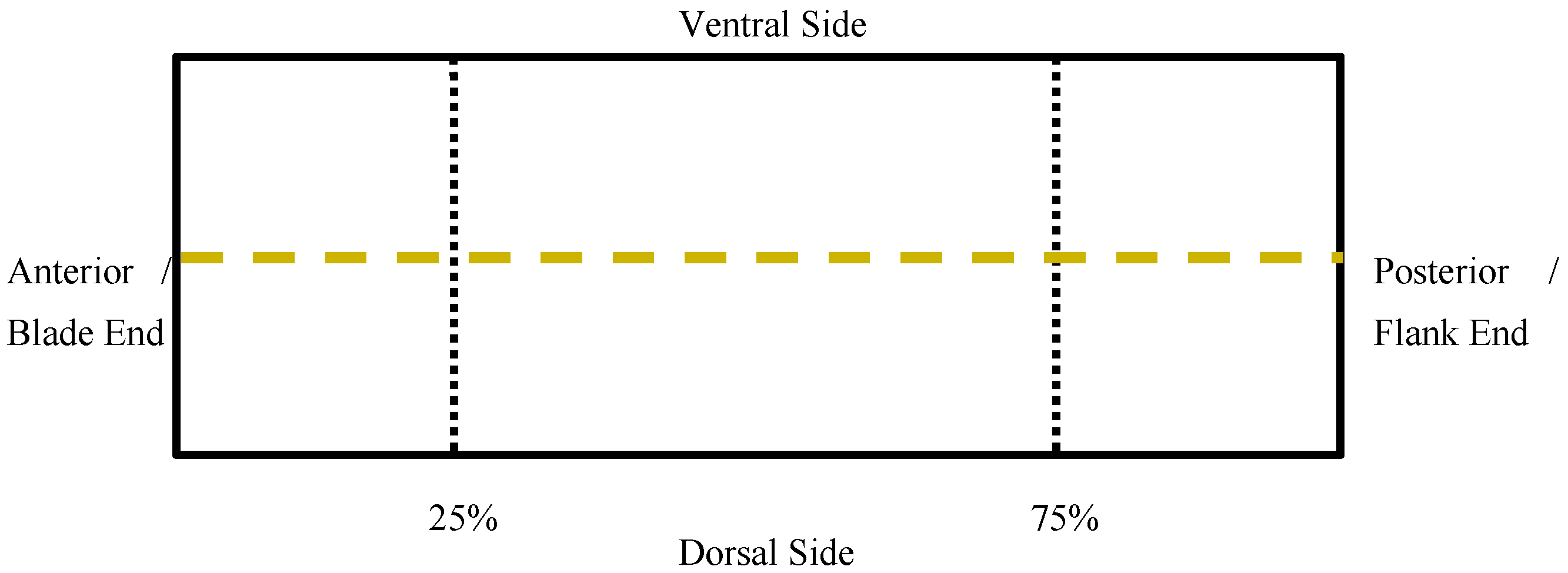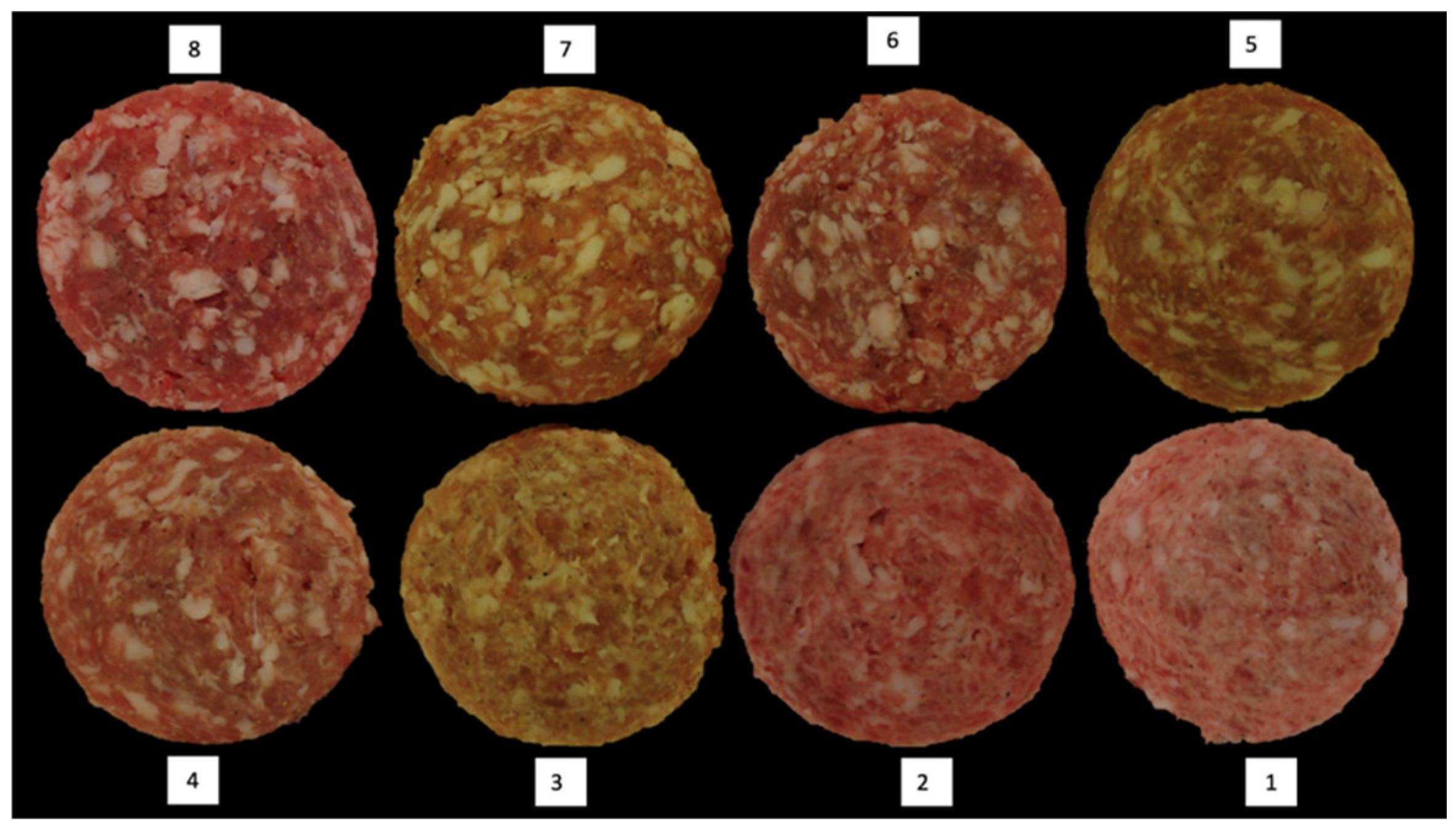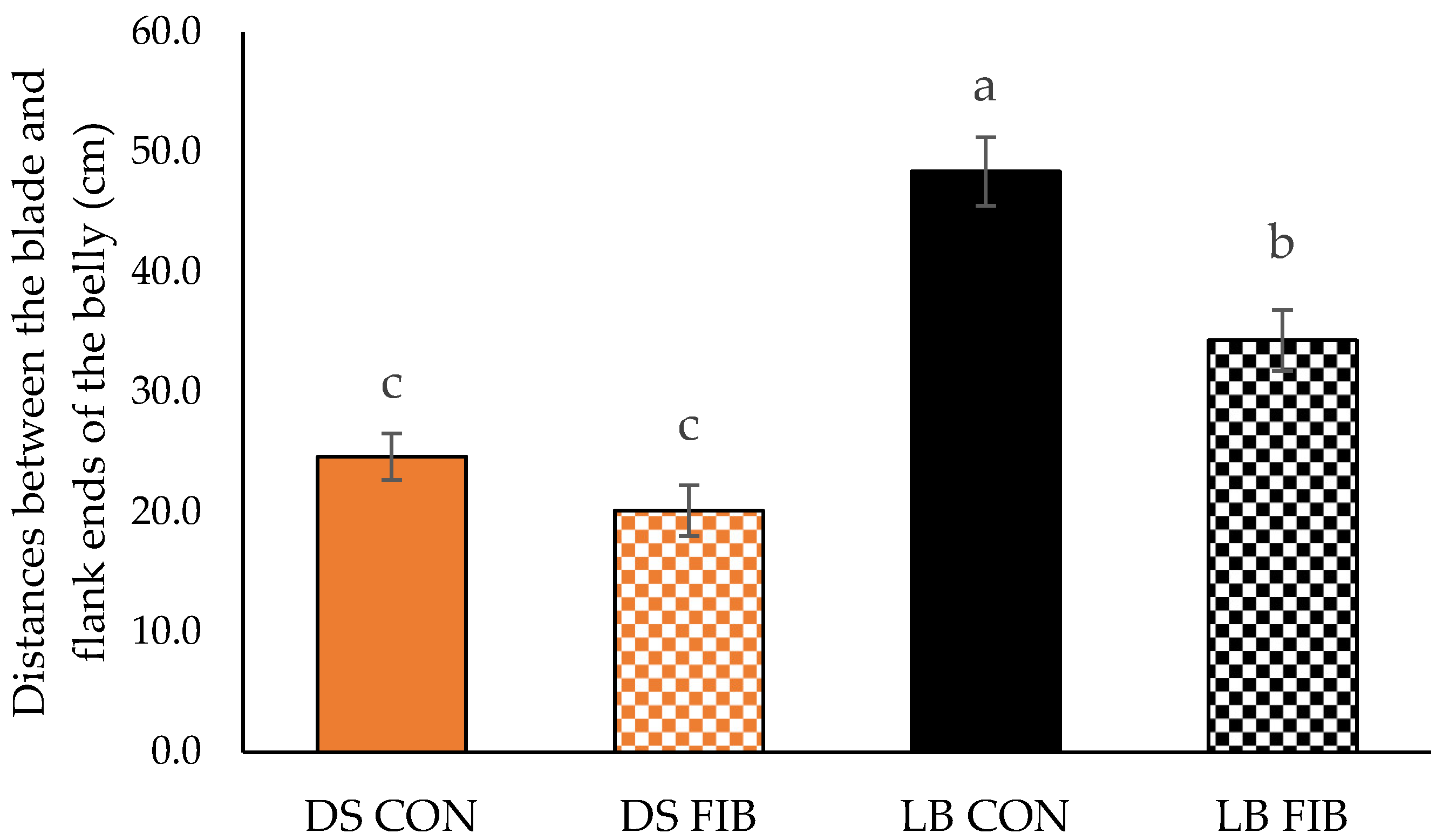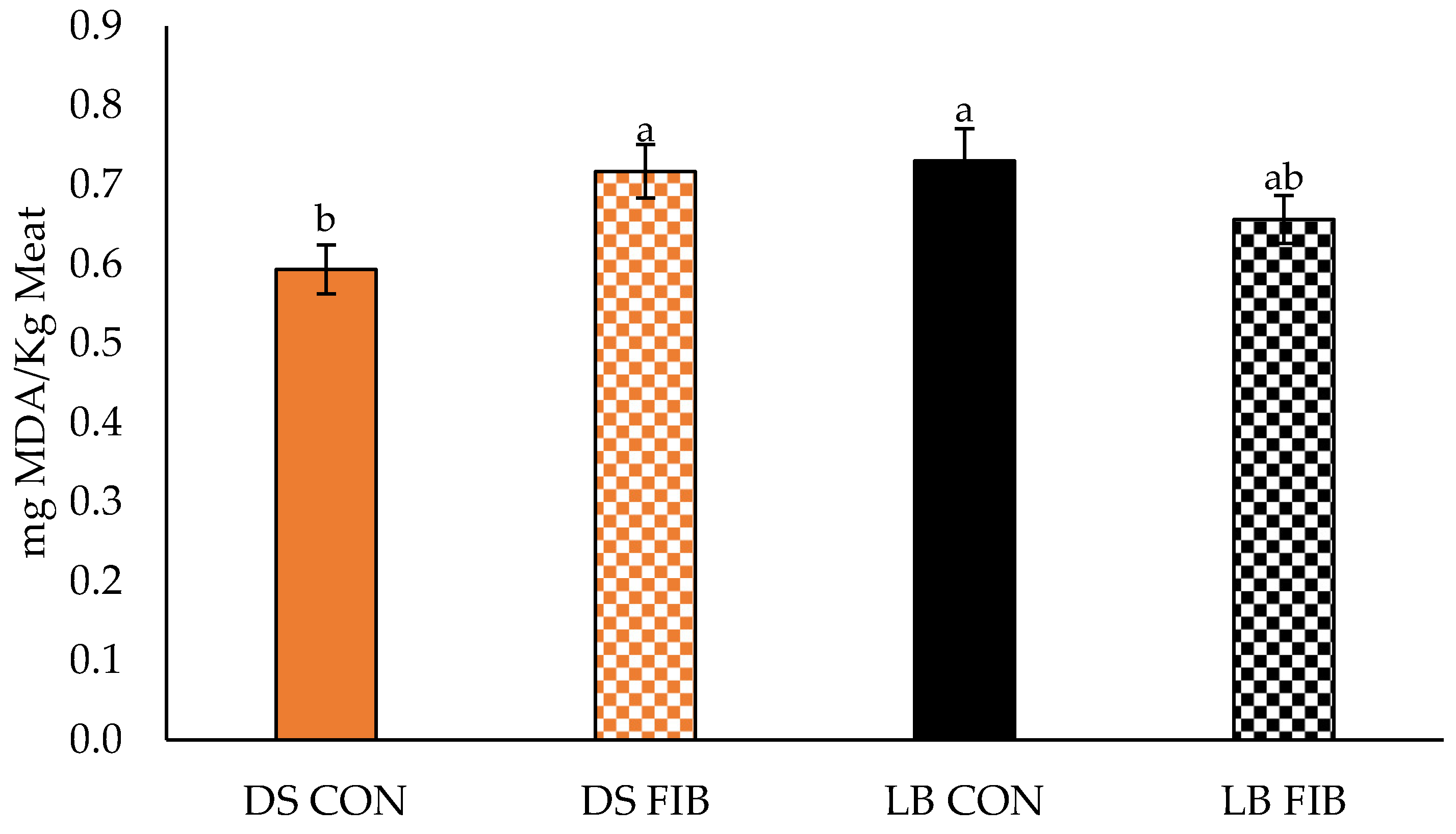Processed Meat Characteristics between Commercial Duroc-Sired and Heritage Breed Large Black Pigs
Abstract
:1. Introduction
2. Materials and Methods
2.1. Animal Harvest
2.2. Boneless Belly
2.3. Sausage
2.4. Color
2.5. Fat Smear
2.6. Lipid Oxidation
2.7. Bacon
2.8. Visual Image Analysis
2.9. Statistical Analysis
3. Results
3.1. Physical Belly Characteristics
3.2. Bacon Quality and Characteristics
3.3. Sausage Characteristics
4. Discussion
5. Conclusions
Author Contributions
Funding
Institutional Review Board Statement
Informed Consent Statement
Data Availability Statement
Acknowledgments
Conflicts of Interest
Appendix A
| Phase 1 63–84 d Age | Phase 2 84–105 d Age | Phase 3 105–126 d Age | Phase 4 126–147 d Age | Phase 5 147–168 d Age | Phase 6 168– | |||||||
|---|---|---|---|---|---|---|---|---|---|---|---|---|
| Ingredient (%) | CON | FIB | CON | FIB | CON | FIB | CON | FIB | CON | FIB | CON | FIB |
| Corn | 66.51 | 59.81 | 69.96 | 60.20 | 74.28 | 60.59 | 78.63 | 61.11 | 81.79 | 60.36 | 83.74 | 57.23 |
| Soybean Meal, 47% CP | 19.10 | 17.55 | 15.60 | 13.71 | 11.48 | 9.15 | 7.40 | 4.50 | 4.55 | 1.20 | 2.55 | 0.00 |
| DDGS, 7% fat | 10.00 | 10.00 | 10.00 | 10.00 | 10.00 | 10.00 | 10.00 | 10.00 | 10.00 | 10.00 | 10.00 | 10.00 |
| Dehydrated Alfalfa Meal | 0.00 | 7.5 | 0.00 | 10.00 | 0.00 | 12.50 | 0.00 | 15.00 | 0.00 | 17.50 | 0.00 | 20.00 |
| Wheat Middlings | 0.00 | 1.00 | 0.00 | 2.00 | 0.00 | 4.00 | 0.00 | 6.00 | 0.00 | 8.00 | 0.00 | 10.00 |
| Swine Grease | 1.00 | 1.00 | 1.00 | 1.00 | 1.00 | 1.00 | 1.00 | 1.00 | 1.00 | 1.00 | 1.00 | 1.00 |
| Limestone | 1.37 | 1.09 | 1.30 | 0.93 | 1.25 | 0.80 | 1.22 | 0.69 | 1.14 | 0.53 | 1.12 | 0.43 |
| MonoCal Phosphorus | 0.53 | 0.53 | 0.47 | 0.45 | 0.37 | 0.30 | 0.21 | 0.10 | 0.16 | 0.00 | 0.23 | 0.00 |
| Vitamin Premix 2,3,4,5,6 | 0.15 | 0.15 | 0.14 | 0.14 | 0.13 | 0.13 | 0.12 | 0.12 | 0.10 | 0.10 | 0.10 | 0.10 |
| TM Premix 7,8,9,10,11 | 0.10 | 0.10 | 0.09 | 0.09 | 0.08 | 0.08 | 0.07 | 0.07 | 0.05 | 0.05 | 0.05 | 0.05 |
| Se Premix 12 | 0.05 | 0.05 | 0.05 | 0.05 | 0.05 | 0.05 | 0.05 | 0.05 | 0.03 | 0.03 | 0.03 | 0.03 |
| Phytase 13 | 0.10 | 0.10 | 0.10 | 0.10 | 0.10 | 0.10 | 0.10 | 0.10 | 0.10 | 0.10 | 0.10 | 0.10 |
| Salt | 0.35 | 0.35 | 0.35 | 0.35 | 0.35 | 0.35 | 0.30 | 0.30 | 0.25 | 0.25 | 0.25 | 0.25 |
| Lysine-HCL | 0.42 | 0.44 | 0.40 | 0.42 | 0.40 | 0.42 | 0.40 | 0.42 | 0.36 | 0.38 | 0.36 | 0.34 |
| DL-Methionine | 0.09 | 0.10 | 0.06 | 0.08 | 0.05 | 0.07 | 0.02 | 0.05 | 0.00 | 0.03 | 0.00 | 0.02 |
| L-Threonine | 0.13 | 0.13 | 0.11 | 0.11 | 0.11 | 0.11 | 0.11 | 0.12 | 0.09 | 0.10 | 0.09 | 0.08 |
| L-Tryptophan | 0.03 | 0.03 | 0.03 | 0.03 | 0.03 | 0.03 | 0.04 | 0.04 | 0.04 | 0.03 | 0.03 | 0.02 |
| Clarify 14 | 0.07 | 0.07 | 0.09 | 0.09 | 0.07 | 0.07 | 0.08 | 0.08 | 0.09 | 0.09 | 0.10 | 0.10 |
| Defusion 15 | 0.00 | 0.00 | 0.25 | 0.25 | 0.25 | 0.25 | 0.25 | 0.25 | 0.25 | 0.25 | 0.25 | 0.25 |
| Total | 100.0 | 100.0 | 100.0 | 100.0 | 100.0 | 100.0 | 100.0 | 100.0 | 100.0 | 100.0 | 100.0 | 100.0 |
References
- Moeller, S.J.; Miller, R.K.; Edwards, K.K.; Zerby, H.N.; Logan, K.E.; Aldredege, T.L.; Stahl, C.A.; Boggess, M.; Box-Steffensmeirer, J.M. Consumer perceptions of pork eating quality as affected by pork qality attributes and end-point cooked temperature. Meat Sci. 2010, 84, 14–22. [Google Scholar] [CrossRef] [PubMed]
- Schwab, C.R.; Baas, T.J.; Stalder, K.J.; Mabry, J.W. Effect of long-term selection for increased leanness on meat and eating quality traits in duroc swine. J. Anim. Sci. 2006, 84, 1577–1583. [Google Scholar] [CrossRef] [PubMed] [Green Version]
- Ngapo, T.M.; Gariépy, C. Factors affecting the eating quality of pork. Crit. Rev. Food Sci. Nutr. 2008, 48, 599–633. [Google Scholar] [CrossRef] [PubMed]
- The Livestock Conservancy. Available online: https://livestockconservancy.org (accessed on 17 September 2021).
- Whitley, N.; Hanson, D.; Morrow, W.; See, M.T.; Oh, S.H. Comparison of pork quality and sensory characteristics for antibiotic free yorkshire crossbreds raised in hoop houses. Asian-Australas. J. Anim. Sci. 2021, 25, 1634–1640. [Google Scholar] [CrossRef] [PubMed]
- Wang, Y.; Thakali, K.; Morse, P.; Shelby, S.; Chen, J.; Apple, J.; Huang, Y. Comparision of Growth Performance and Meat Quality Traits of Commecial Cross-Bred Pigs versus the Large Black Pig Breed. Animals 2021, 11, 200. [Google Scholar] [CrossRef] [PubMed]
- United States Deparment of Agriculture. Available online: https://www.ams.usda.gov/grades-standards/imps (accessed on 1 October 2021).
- Rentfrow, G.; Sauber, T.E.; Allee, G.L.; Berg, E.P. The influence of diets containing either conventional corn, conventional corn with choice white grease, high oil corn, or high oil high oleic corn on belly/bacon quality. Meat Sci. 2003, 64, 459–466. [Google Scholar] [CrossRef]
- Buege, J.A.; Aust, S.D. Microsomal lipid peroxidation. In Methods in Enzymology; Elsevier: Amesterdam, The Netherlands, 1978; Volume 52, pp. 302–310. ISBN 978-0-12-181952-1. [Google Scholar]
- Scramlin, S.M.; Carr, S.N.; Parks, C.W.; Fernandez-Dueñas, D.M.; Leick, C.M.; McKeith, F.K.; Killefer, J. Effect of ractopamine level, gender, and duration of ractopamine on belly and bacon quality traits. Meat Sci. 2008, 80, 1218–1221. [Google Scholar] [CrossRef]
- Lo, L.L.; McLaren, D.G.; McKeith, F.K.; Fernando, R.L.; Novakofski, J. Genetic analyses of growth, real-time ultrasound, carcass, and pork quality traits in Duroc and Landrace pigs: I. Breed Effects. J. Anim. Sci. 1992, 70, 2373–2386. [Google Scholar] [CrossRef] [Green Version]
- McGloughlin, P.; Allen, P.; Tarrant, P.V.; Joseph, R.L.; Lynch, P.B.; Hanrahan, T.J. Growth and carcass quality of crossbred pigs sired by Duroc, Landrace and Large White boars. Livest. Prod. Sci. 1988, 18, 275–288. [Google Scholar] [CrossRef]
- Sivendiran, T.; Wang, L.M.; Huang, S.; Bohrer, B.M. The effect of bacon pump retention levels following thermal processing on bacon slice composition and sensory characteristics. Meat Sci. 2018, 140, 128–133. [Google Scholar] [CrossRef] [PubMed]
- Fan, X.J.; Liu, S.Z.; Li, H.H.; He, J.; Feng, J.T.; Zhang, X.; Yan, H. Effects of Portulaca Oleracea L. extract on lipid oxidation and color of pork meat during refrigerated storage. Meat Sci. 2019, 147, 82–90. [Google Scholar] [CrossRef] [PubMed]






| Breed 1 | Diet 2 | |||||||
|---|---|---|---|---|---|---|---|---|
| Belly Characteristics | DS | LB | SEM | Significance of p-Value | CON | FIB | SEM | Significance of p-Value |
| Fresh belly wt (kg) | 6.64 a | 5.78 b | 0.24 | <0.001 | 6.64 a | 5.88 b | 0.24 | 0.001 |
| Belly length (cm) | 64.07 a | 59.34 b | 1.17 | <0.001 | 63.54 a | 60.26 b | 1.30 | 0.005 |
| Belly thickness (cm) | 3.72 a | 4.08 b | 0.18 | 0.026 | 4.27 a | 3.61 b | 0.17 | <0.001 |
| Belly firmness (cm) 3 | 22.08 a | 40.49 b | 0.78 | <0.001 | 36.48 a | 27.20 b | 3.75 | <0.001 |
| Pump uptake (%) 4 | 10.10 | 9.80 | 0.21 | 0.139 | 9.72 | 10.13 | 0.21 | 0.053 |
| Processing yield (%) 5 | 90.62 a | 89.67 b | 0.28 | 0.001 | 90.27 | 90.05 | 0.31 | 0.439 |
| Breed 1 | Diet 2 | |||||||
|---|---|---|---|---|---|---|---|---|
| Processing Characteristics | DS | LB | SEM | Significance of p-Value | CON | FIB | SEM | Significance of p-Value |
| SA (cm2) 3 | 98.36 | 96.54 | 4.42 | 0.676 | 102.39 a | 93.56 b | 4.21 | 0.048 |
| Total slice length (cm) 4 | 24.37 | 23.12 | 0.66 | 0.065 | 23.58 | 23.89 | 0.67 | 0.645 |
| Lean area (%) 5 | 39.67 a | 19.35 b | 1.13 | <0.001 | 28.63 | 30.20 | 3.12 | 0.203 |
| Fat smearing score 6 | 3.56 | 3.32 | 0.21 | 0.398 | 3.86 a | 3.11 b | 0.16 | 0.010 |
Publisher’s Note: MDPI stays neutral with regard to jurisdictional claims in published maps and institutional affiliations. |
© 2022 by the authors. Licensee MDPI, Basel, Switzerland. This article is an open access article distributed under the terms and conditions of the Creative Commons Attribution (CC BY) license (https://creativecommons.org/licenses/by/4.0/).
Share and Cite
Guo, Y.; Sharp, K.; Blackburn, H.; Richert, B.; Stewart, K.; Zuelly, S.M.S. Processed Meat Characteristics between Commercial Duroc-Sired and Heritage Breed Large Black Pigs. Foods 2022, 11, 2310. https://doi.org/10.3390/foods11152310
Guo Y, Sharp K, Blackburn H, Richert B, Stewart K, Zuelly SMS. Processed Meat Characteristics between Commercial Duroc-Sired and Heritage Breed Large Black Pigs. Foods. 2022; 11(15):2310. https://doi.org/10.3390/foods11152310
Chicago/Turabian StyleGuo, Yufei, Katharine Sharp, Harvey Blackburn, Brian Richert, Kara Stewart, and Stacy M. S. Zuelly. 2022. "Processed Meat Characteristics between Commercial Duroc-Sired and Heritage Breed Large Black Pigs" Foods 11, no. 15: 2310. https://doi.org/10.3390/foods11152310
APA StyleGuo, Y., Sharp, K., Blackburn, H., Richert, B., Stewart, K., & Zuelly, S. M. S. (2022). Processed Meat Characteristics between Commercial Duroc-Sired and Heritage Breed Large Black Pigs. Foods, 11(15), 2310. https://doi.org/10.3390/foods11152310






